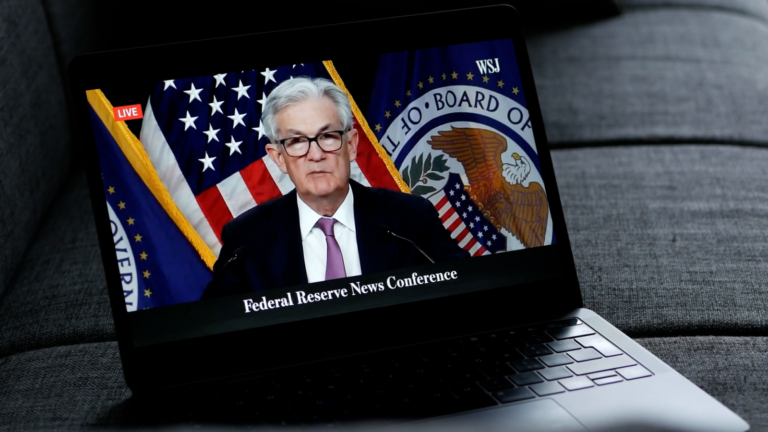Jerome Powell went out with a bang. His final Jackson Hole speech as Federal Reserve Chair wasn’t just dovish – it was a parting shot that could reshape markets for the rest of the year.
Wall Street cheered the message. Stocks rallied, Treasury yields slipped and traders quickly priced in not just a September rate cut, but the possibility of several more after that.
Now, you may recall I told you back in July that the Fed’s delay in cutting rates was a mistake (here’s that piece).
Then, earlier this month, I showed how the latest data all but guaranteed a September cut (you can read that one here). So, Powell’s farewell speech at Jackson Hole on Friday all but confirmed it.
So, in today’s Market 360, I’ll explain how it seems like Powell finally got the message. We’ll go over exactly what he said, and I’ll discuss how it ties back to the warnings I’ve been making for months. We’ll also talk about why it matters for your portfolio – and wrap up by telling you about the hidden corner of the market where I’m expecting to find the market’s next big winners…
Setting the Stage
Every August, central bankers, economists and policymakers gather in Jackson Hole, Wyoming for the Kansas City Fed’s annual economic symposium. It’s one of the most closely watched events of the year.
The theme this time was “Labor Markets in Transition: Demographics, Productivity and Macroeconomic Policy.” That couldn’t have been more fitting. The labor market has been flashing warning signs for months now.
We’ve seen high-profile layoffs at Cisco Systems Inc. (CSCO), Oracle Corp. (ORCL) and Deere & Co. (DE). Tech has cut more than 150,000 jobs in 2024 and another 22,000 so far this year. Even universities like George Washington, Boston and Brown have announced job cuts.
And the official data has been just as troubling. The July jobs report showed only 73,000 new jobs – with unemployment ticking up to 4.2%. Even worse, May and June payrolls were revised way down. May’s original estimate of 125,000 jobs was slashed to just 19,000, while June fell from 147,000 to only 14,000.

Despite all this, the July Fed meeting minutes still showed most officials focused more on inflation than employment. That’s why Powell’s speech came as such a surprise.
What Powell Actually Said
Powell struck a very different tone in Jackson Hole. He said the “shifting balance of risks may warrant adjusting our policy stance.” He also admitted that “downside risks to employment are rising.”
Translated from Fedspeak, that means the Fed is finally shifting its focus from inflation to jobs. Powell even conceded that tariffs might have a one-time inflationary impact, but the bigger risk now is the weakening labor market.
This was a sharp turn from just a few weeks ago, when the July Fed minutes showed no labor concerns at all. But as Fed Governor Christopher Waller had warned on Bloomberg, the labor market was in trouble – and the later revisions proved him right. Now Powell is acknowledging it, too.
Now here’s the real kicker – the part that got Wall Street buzzing. Powell said:
Our policy rate is now 100 basis points closer to neutral than it was a year ago. And the stability of the unemployment rate and other labor market measures allows us to proceed carefully as we consider changes to our policy stance.
That’s a mouthful. But what he really said is simple: The Fed still believes rates are too high.
Remember, the Treasury Secretary, Scott Bessent, has been calling for 150 basis points of cuts. Powell didn’t go that far. But by admitting we’re 100 basis “closer to neutral,” he basically confirmed that a full easing cycle is coming sooner or later.
This is why markets ripped higher. Not just because of September, but because the door is now open to multiple cuts over the next several months.
Consumer Spending, Housing and Inflation
Powell also highlighted something I’ve been watching closely: consumer spending. He said, “The decline in growth has largely reflected a slowdown in consumer spending.”
That’s no small thing. When consumers pull back, the entire economy slows. It’s exactly why the Fed can no longer ignore the jobs side of its mandate.
Housing data also supported his case. The National Association of Realtors reported this week that existing home sales in July rose 2% to a 4 million annual pace. That beat expectations for a decline. But hidden in that report was the more important number: median home prices are up only 0.2% in the past 12 months.
That’s critical because shelter inflation has been one of the stickiest parts of inflation. We’ve talked before about owner’s equivalent rent — the measure of housing costs inside the Consumer Price Index (CPI). It’s been stubbornly high for far too long, but it has finally started cooling in recent months. This latest data confirms that this cooling is real and likely to continue to persist.
Bottom line, home prices are barely moving higher, and rents are starting to flatten. If you take away shelter costs, the inflation picture looks much more tame. And that’s why I believe Powell finally felt comfortable flipping the script.
The Takeaway
Wall Street wasted no time responding. The S&P 500 jumped 1.5% today on Powell’s remarks, while the 10-year Treasury yield slipped to 4.26%.
Part of the move was mechanical – short covering after mean-reversion algorithms tried to push winning stocks lower earlier in the week. But make no mistake, Powell’s dovish tone was the real driver. When the Fed signals it’s ready to ease, investors listen.
Traders now see a September rate cut as all but certain, as you can see in the chart below.

August is still a choppy month, and we could see more volatility in September, too.
But the main thing to keep in mind is that we now have a much better backdrop for our fundamentally superior stocks.
How to Prepare for What’s Next…
So, what does all this mean for Powell’s legacy?
To be blunt, he waited too long. I’ve been saying for months that the Fed’s delay in cutting rates was a mistake. We saw it in the weak jobs report, we saw it in the massive payroll revisions and we saw it in the cracks forming across the labor market.
But I’ll give Powell this – at least he went out doing the right thing. His final Jackson Hole speech was his most dovish yet. He finally shifted focus from an inflation fight that had already been won to a labor market that’s clearly softening.
That may not erase the damage from past mistakes (anyone remember “transitory” inflation?). But it does set the stage for what comes next…
See, Powell’s dovish farewell sets the stage for the next major investing cycle. Once the Fed begins cutting, capital starts hunting for growth opportunities. And when you combine that with President Trump’s new economic agenda, we could see a tidal wave of money flowing into select corners of the market.
That’s why I’ve been telling my followers about Executive Order #14196 – the directive that I believe will lead to the creation of America’s first sovereign wealth fund – or what I call the MAGA Fund.
See, most folks don’t know it, but there are “reserve accounts” all across the country – in places like Texas, Alaska and Pennsylvania. They’re worth trillions of dollars. And for the first time ever, Washington is planning to unlock that wealth and channel it into a handful of little-known public companies that manage these assets.
It’s unlike anything we’ve seen before, and it could soon unleash trillions of dollars in government-backed investment.
I’ve done the homework. After months of research, I’ve identified a handful of companies that I believe are directly in line to benefit. And if I’m right, their shares could skyrocket once the money starts flowing.
That’s why I put together a special briefing that details everything you need to know.
Click here now to learn more and get ahead of the crowd now.
Sincerely,

Louis Navellier
Editor, Market 360
The Editor hereby discloses that as of the date of this email, the Editor, directly or indirectly, owns the following securities that are the subject of the commentary, analysis, opinions, advice, or recommendations in, or which are otherwise mentioned in, the essay set forth below:
Cisco Systems Inc. (CSCO)

